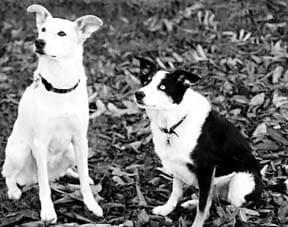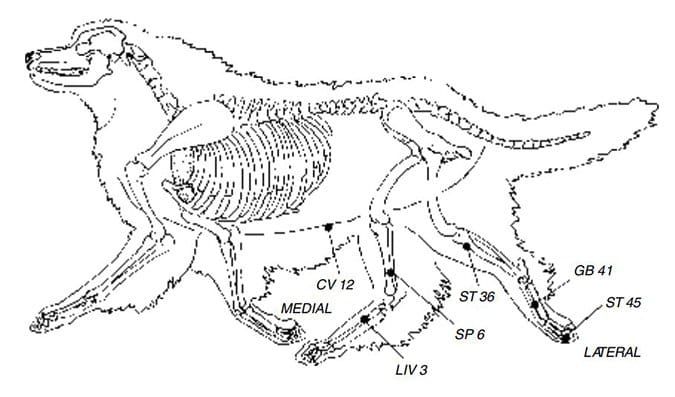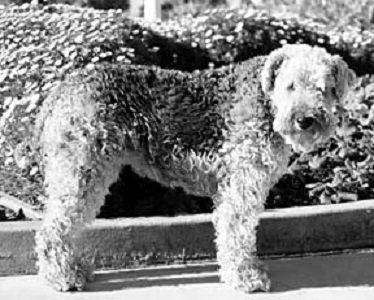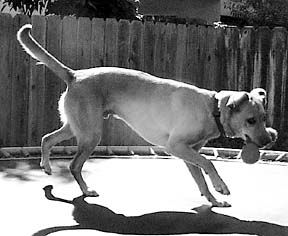ADHD in Dogs: Overview
- Evaluate your dog carefully to determine if he is truly hyper-active, or just has a “normal” amount of high energy.
- Seek veterinary assistance if he is truly hyperactive; you may need to use medication in conjunction with a positive behavior modification program.
- Provide a structured environment and maximize his opportunities for exercise, training, and socialization. Feed your dog a good quality, low protein, non-allergenic, additive-free diet.
A disconcerting number of my clients preface the explanation of their dogs’ undesirable behaviors with the pronouncement, “He is really hyper!” The vast majority of the time, they have perfectly normal dogs. The explosion of apparently “hyper” dogs in our world can be traced to several factors:
• The popularity of breeds that are (when well-bred) genetically programmed to have enhanced environmental alertness, vigilance, and high activity levels. While high activity levels are distributed across all breeds (I am personally acquainted with a high-energy Basset Hound), they are especially prevalent in the sporting breeds (Labradors Retrievers, Golden Retrievers, etc.) and herding breeds (Border Collies, Australian Shepherds, etc.).
• The puppy-milling and retail sale of those popular breeds that results in poorly bred, poorly socialized pups ending up in the hands of owners underprepared to care for and train them.
• Unreasonable expectations of dog behavior by owners who have a poor understanding of their dogs’ needs and behaviors, which results in…
• Lack of adequate exercise and socialization.
Can Dogs Have ADHD? Yes, but it’s Over Diagnosed
That said, hyperactivity does exist in dogs. It is, however, greatly over diagnosed. Hyperactivity, otherwise known as “hyperkinesis,” can be defined as dogs who display frenetic activity, abnormally short attention spans, and high impulsiveness. They can also demonstrate overbearing attention-seeking behavior. It is truly a canine form of Attention Deficit Hyper-activity Disorder (ADHD). Like some children who are prescribed Ritalin or some other stimulant, it seems that some dogs who are truly hyperkinetic can benefit from the administration of stimulants to help them focus and pay attention.
What differentiates a normal, high-energy dog from one who has ADHD? Dogs with ADHD demonstrate exceptionally short attention spans and a high degree of impulsiveness that makes it impossible for them to focus on one task for long. They are easily distracted.
In contrast, most of the high-energy dogs that clients bring to me will focus very quickly on the click-and-treat game. They are normal, active dogs who haven’t learned how to control their own behavior – but they can, if you show them how. In fact, owners are often amazed by the undivided attention their previously intractable canine companions will offer – as soon as we give the dogs a reason to focus; when we show them that focused attention makes good stuff happen. The truly hyperactive dog can’t focus even if she wants to; everything she encounters, regardless of how trivial or irrelevant, is given equal and minimal, active but fleeting interest.
Hyperactive dogs also tend to be especially sensitive to sudden environmental changes – overreacting to the presence of a strange person or animal, and apparently unable to adjust to the new stimulus. In addition, they seem to have an intolerance for boredom and an exaggerated need for novelty and variety. They don’t do well with repetitive tasks (such as basic obedience drills), but may excel in situations requiring creative solutions, such as the Border Collie who often must think for himself and make his own decisions about how to move the sheep.
Hyperactive dogs also are likely to get into everything (bored, looking for creative opportunity), can be destructive, and are often emotionally unstable. They can become almost unmanageable if physically restrained, and may exhibit uncontrollable rage-like aggression if frustrated.
Causes and Effects of Hyperactivity in Dogs
Like so many other behaviors, hyperactivity is believed to result from a mix of genes and environment – nature versus nurture. Certainly, the high-energy breeds previously mentioned are more prone to develop true hyperactive behaviors, but a dog’s genes are just the canvas that his personality is painted on by life, training, and socialization experiences. Hyperactivity can be minimized or exacerbated from puppyhood on, depending on social and environmental factors.
Excitable dogs can often be identified early. They are frequently the puppies who continually bite at hands and fight any attempt to restrain or control them – not with just a mild struggle, but with violent resistance. An excitable puppy placed into a calm, structured environment, with an owner who provides adequate exercise, socialization, and training, has a good chance of growing up to be a well-behaved, albeit active, canine companion. In the wrong environment, this pup is a disaster.
Exposure to overly active and playful children can feed hyperactivity – just one of many reasons that interactions between children and dogs should be very closely supervised. Excitable children tend to do exactly the wrong things in response to an excitable puppy’s inappropriate behaviors – hitting back, restraining, running, or screaming – all of which are guaranteed to escalate the pup’s level of excitement. Even a pup with a moderate activity level can be induced into hyperactivity in the wrong environment.
As many trainers will testify, social isolation also makes a significant contribution to hyperactive behavior. We often encounter the conundrum of the owner who promises to bring Rex into the house as soon as Rex learns to be well-behaved, but Rex can’t learn to be well-behaved when he is experiencing the activity-increasing effects of social deprivation.
A 1961 study conducted by Waller and Fuller found that puppies raised in semi-isolation exhibited excessive social contact behavior when given limited access to other puppies. When kept with their litters, the number of social contacts reduced by 75 percent. One conclusion of this study is that dogs may possess a biological need for a certain minimum amount of daily social stimulation and activity, and if that need is not met, a dog compensates with excessive activity when placed in a social situation.
It is likely that the minimum amount of social stimulation needed varies from one dog to the next. When faced with a dog who has higher-than-anticipated social needs, some owners resort to routine isolation of the dog in order to deal with the unwanted behaviors. This results in inadequate attention, insufficient exercise, and excessive confinement, adding fuel to the fire and creating a vicious cycle. When the dog is released from his confinement his behavior is worse than ever, which results in more isolation, and further decline of behavior. His chances of ever becoming a housedog grow dimmer.
Some physiological conditions are believed to play a role in canine ADHD as well. In a study published in 1999 by Drs. Jean Dodds and Linda Aronson, in collaboration with Drs. Nicholas Dodman and Jean DeNapoli of Tufts University, 634 dogs were evaluated for thyroid dysfunction as it related to various behavior problems. Forty-two of those dogs were determined to be hyperactive; thirty-one percent of the hyperactive dogs (13) were diagnosed with thyroid dysfunction.
Of 95 dogs in the study whose behavioral responses to thyroid therapy were evaluated, 81 dogs (85.3 percent) showed at least a 25 percent improvement in their behavior. Thirty-four of the dogs (35.6 percent) showed better than 75 percent improvement. Of 20 dogs treated with conventional methods and modification techniques over the same time period, only 11 (55 percent) improved by at least 25 percent.
Chronic lead poisoning is also a potential cause of hyperactivity in dogs. Two common sources are destructive chewing on old linoleum or on surfaces painted with lead-based paints.
There is also evidence to suggest that inadequate nutrition, especially early in life, may permanently affect activity levels throughout the remainder of a dog’s life. This means that the importance of proper nutrition during puppyhood cannot be overstated. Breeders must be sure that puppies in large litters or those born to mothers with insufficient milk receive adequate nutrition from other sources, and that the mother’s dietary intake can meet the demands of a nursing litter. It has been suggested that a diet high in protein, or containing elements to which a dog is allergic, may also contribute to hyperactive behavior.
Although the scientific jury is still out on the role that food additives and colorants play in hyperactive behavior, and, in fact, many studies have not found a direct correlation, a 1980 study did find a sharp decrease in hyperactive symptoms when dogs were put on a 28-day-additive free diet.
Working with “Normal” High-Energy Dogs
Say you determine that you have a high-energy dog, rather than a hyperactive one. That may be good news, but you still need to deal with your out-of-control canine. Here are some tips to help you turn your Wild Willy into a Gentle Bill:
Increase the Structure in Your Dog’s Environment
Teach him to “say please” (sit) to make good things happen. Have him sit for his dinner bowl. Have him sit for his leash to go for a walk. Have him sit to make the door to the backyard open. Have him sit to be petted, or get a cookie for coming back inside. (See “Why Force-Based Training Methods are Not Advocated.” )
Exercise More with Your Dog
Whatever he gets now, give him more, and make it quality exercise. Tossing him out in the backyard is not quality exercise. Go out with him. Throw sticks, balls, play tug of war, get him to swim in the pond, take him to the dog park. And add structure to his exercise. Have him sit politely for you to throw the ball. Make sure he will “Give” you the tug toy when you ask him to. Have him sit before you open the gate into the park.
Increase Your Dog’s Socialization
If you’ve been leaving him outside because he’s too wild, grit your teeth and bring him in. Use leashes, tethers, crates, and baby gates as needed to preserve your sanity while integrating him into the family.
Step Up Your Dog’s Training
If you’ve already taken him to a basic training class, sign up for a Level 2. Or a tricks class, or agility – anything that will keep the two of you active and learning together. Keeping his brain occupied and busy is just as important as occupying his body.
Conduct a 10-Minute ADHD Test for Your Dog
How can you tell if you have a “normal” high-energy dog or one with ADHD? The proof is in the Ritalin. Your veterinarian can administer a low dose of an appropriate amphetamine after measuring your dog’s respiration, heart rate, and reaction to restraint. Some 30-120 minutes after the amphetamine is given, most hyperkinetic dogs will show a marked decrease in excitement and activity level as well as a measurable drop in respiration and heart rate, and greater acceptance of restraint. A normal-but-active dog will have the opposite response, with an increase in excitement, activity, heart rate, and respiration, and a decreased tolerance of restraint.
First, however, you might want to try an ADHD experiment at home. Make sure your high-energy dog hasn‘t eaten for at least four hours. Take him out for a good hard romp in a safely enclosed area to take the edge off – don’t run him into exhaustion. Then leash your dog, grab your clicker and a treat bag full of very high value treats, and take him to a place with minimal distractions (indoors) for some clicker-testing fun:
1. “Supercharge” your clicker, using a very high rate of reinforcement and tiny treats for 1 minute (30-60 treats per minute). Click the clicker; and then feed the dog a smidgen of chicken for each click. Click, treat. Click, treat. Your dog doesn’t have to do anything but focus on you; don’t ask for sit, down, stay, or any other behavior. If he tries to jump on you, turn away, but keep clicking and giving him treats. Be sure to deliver the treats at his nose level so he doesn’t have to jump up to get them. If he’s grabby, toss the treats on the floor in front of him.
2. After 1 minute, reduce the rate of reinforcement to 15-30 clicks/treats per minute. Start moving the treat over his head to lure a sit. If he does sit, briefly increase the rate of reinforcement for three to four clicks, then slow down again. Do this for 2 minutes.
3. For the next 2 minutes, continue at a reinforcement rate of 10-20 clicks/treats per minute, but now, if he sits, click the clicker but hold off delivering the treat for 2 seconds at first, gradually increasing the delay of the treat‘s delivery for up to 4 or 5 seconds.
4. For 2 more minutes, click and treat on a variable/random schedule of reinforcement. That is, vary the number of seconds between clicks and treats, sometimes doing several click/treats rapidly in a row (remember to treat after each click) sometimes pausing for 1 second, or 5, or 3, or 7, between clicks. Try to keep it random; we humans are very good at falling into patterns!
5. Now, stop clicking for 30 seconds.
6. After 30 seconds, click the clicker only if he looks at you. If he keeps looking at you, keep clicking, using the random reinforcement schedule in Step 4. If he looks away, stop clicking. If he looks back at you or looks in your general direction, click again. Do this for 2% minutes.
Time’s up – the test is over!
If your dog was willing to play this game with you for the entire 10 minutes with only occasional minor attention lapses, you probably have a normal high-energy dog. It‘s time to increase his exercise, socialization, and training programs.
If, however, you lost your dog’s attention totally somewhere between Steps 2 and 4, there’s a good chance you really do have a hyperkinetic dog. Time to call your vet to schedule that amphetamine test, and while you’re there, have a full thyroid panel done as well as a blood test for lead poisoning. Remember that thyroid results within the clinically normal-but-low range can be a contributing factor to behavior problems.
The ADHD Difference
What do you do if you conclude that your dog has ADHD? In some cases, these dogs exhibit behaviors that are so intrinsically driven by organic causes that behavior modification and positive training alone can’t help.
Fortunately, a high percentage of ADHD dogs can be helped with the judicious use of stimulants in combination with a behavior modification program. Hyperactive dogs tend to be very responsive to positive reinforcement shaping procedures in conjunction with brief time-out periods.
Think back to the results of your 10-minute ADHD test. At what step did you start to lose your dog? If he was with you through Step 2 and you lost him at 3, you know that he does well with a continuous schedule of reinforcement at a fairly high rate.
Go back to the step where he did well (Step 2), and work toward Step 3, breaking your “gradually” into even smaller increments – perhaps a half-second rather than a full second – so you don’t lose him with too big a leap.
Keep your expectations low. Shape most of his behaviors in very tiny increments with a high rate of reinforcement. Keep your training session brief (five minutes, maximum), with a short time-out to calm him before you start another brief session.
Sample Task for ADHD Dogs
With many dogs, lure-shaping a down is a simple matter, accomplished in short order by moving the treat toward the floor and clicking the dog for following into a down position. We often have success in just three or four clicks, as we hold the treat at the dog’s nose and he focuses on it (click and treat), we move it halfway to the floor and he follows (click and treat), three-quarters of the way and his feet are sliding forward (click and treat), and he’s down (click and a jackpot of treats!).
In contrast, the hyperkinetic dog may require 20 or even 100 clicks, over several sessions, before you reach your final behavior goal. Teaching “Down” to this dog might require the following:
• The dog is sitting. You hold a treat in front of his nose and he focuses on it. Click and treat.
• He stays focused on the treat. Click and treat.
• Lower the treat a half-inch. His nose follows. Click and treat.
• He stays focused. Click and treat.
• Lower the treat another half-inch. He follows. Click and treat.
• Lower another half-inch. He follows. Click and treat.
• He stays focused. Click and treat.
• Release him from the sit, tell him he’s a great dog, and both of you take a five-minute brain break.
• Start with the sit again. As soon as he focuses on the treat, click and treat.
• Lower the treat an inch. His nose follows. Click and treat.
• Lower the treat another inch. He follows. Click and treat.
• He stays focused. Click and treat.
• Lower the treat another inch. Click and treat.
• He stays focused. Click and treat.
• Lower the treat another inch. Click and treat.
• Take another brain break.
You get the idea: slow and steady. Anytime you increase the increment, say from 1 inch to 2 inches, make sure he stays with you. If you lose him between 1 and 2 inches, go from 1 inch to 1½ inches. Take frequent brain breaks, and don’t make your total session more than about 15 minutes. If you lose his attention a lot, you are expecting too much. Use smaller increments, a higher rate of reinforcement (click him often just for staying with the game), and more breaks.
You never know, with patience, in the right positive environment, your “hyper” pal may turn out to be a great agility, herding, tracking, or drug-sniffing dog!












